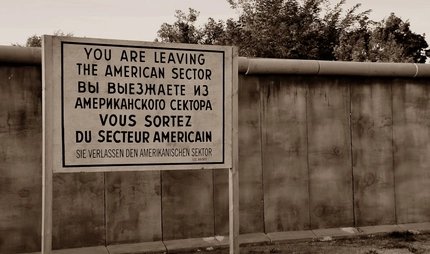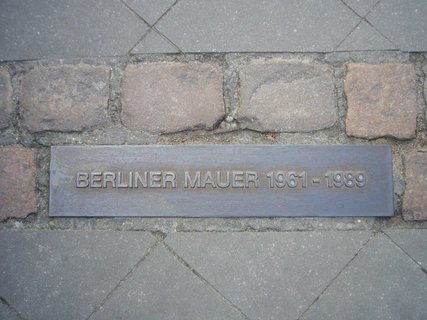
The former Berlin Wall stood from 1961 to 1989 and divided the city of Berlin into an eastern and a western part. Little remains of the Wall itself. We take you on a cycle tour around the Wall Cycle Route and stop at well-known and lesser-known sights and places worth seeing.
Here are our special tips along the Wall Cycle Path:
Tip 1: What you should know in advance

The Wall Trail runs along the former border strip and circles West Berlin once over a distance of 160 kilometres. The cycle path is largely well developed and you don't need any special skills or fitness levels to cycle the entire route. Steles are set up along the entire route of the Wall Trail. They inform you about the tragic history of the many people who lost their lives here. Look out for the Berlin Wall Trail signage, which accompanies you along the entire route.
By the way: the signage is 4.20 metres high, which corresponds to the height of the border wall.
What you should know about the Berlin Wall
Tip 2: Experience the route

The route runs 50 kilometres through the city. While residents used to look out at the Wall from their flats, today large parts of the death strip have been redeveloped. And on the street, a double row of cobblestones marks the former course. Some sections of the border fortifications run along wide fields, through forested areas and along meadows and fields. If you are travelling in spring, you will encounter Japanese cherry blossoms along many stretches, such as on the cherry blossom avenue between Teltow and Lichterfelde, which immerse the route in a sea of pink flowers. Other sections take you to the water: you cycle along the Spree, the Teltow Canal and the Havel, and if you like, also via Wannsee, the Britzer Verbindungskanal and Glienicker See.
Tip 3: Start at the official starting point of the Berlin Wall Trail
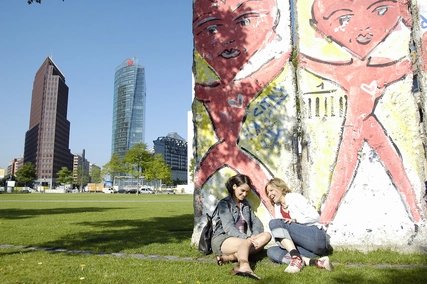
The Potsdamer Platz was Berlin's transport hub in the 1920s. The first traffic lights on the continent were installed here as early as 1924. Completely destroyed during the Second World War, the Berlin Wall divided the square and left the area derelict. It was only after reunification that a new urban centre was created here in just a few years. A few remains of the wall and a metal strip embedded in the ground are reminders of the course of the wall. A giant QR cobble in the ground directly in front of the Deutsche Bahn tower allows you to travel back in time to an exciting interactive era with historical panoramic images.
Tip 4: Continue exploring the city centre

In the immediate vicinity, you will reach the Peter Fechter Memorial. A place for reflection. The memorial site is equipped with a stele and a commemorative plaque that refer to his fate. The memorial also commemorates all the victims of the Wall and the history of division. Here you are encouraged to think about freedom and human rights. Not far away you will find the former border crossing Checkpoint Charlie, one of the most famous sites of the Berlin Wall. The East Side Gallery is also world-famous: It is the longest remaining section of the Wall, which stretches more than 1.3 kilometres along the banks of the Spree and was converted into a gallery in 1990 after the fall of the Wall. Take your time to view the murals, which were created by around 100 artists.
Tip 5: Cycle on quieter paths
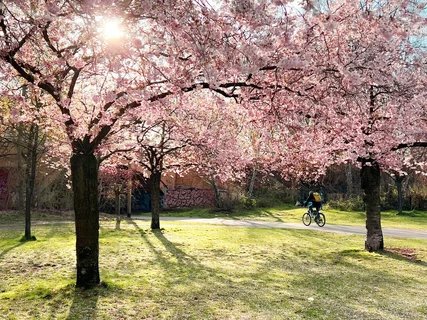
Leave the city centre via Sonnenallee and cycle along the Teltow Canal. A quiet section with numerous steles that provide information about the fates of the victims of the Wall. The route extends as far as Lichtenrade and soon leads to the old colonnade path of the GDR border posts. This section ends in Kirschblütenallee, where 1,000 cherry trees were planted to decorate the border strip. If you're here at the end of April, enjoy the blossoms and linger on the benches along the way.
The Teltow Canal was built in the early 20th century to improve the waterway between the Havel and Spree rivers. With the division of Berlin in 1961 and the construction of the Berlin Wall, the canal took on strategic importance. The border ran close to the canal and the area was heavily guarded in the first few years after the Wall was built. Some of the crossings and bridges over the canal were closed or controlled. After the fall of the Wall in 1989, the Teltow Canal also became a symbol of reunification. Today, there are many memorials and plaques along the canal that commemorate this eventful time in Berlin's history.
11 places to see remains of the Berlin Wall
Tip 6: Discover enchanted history
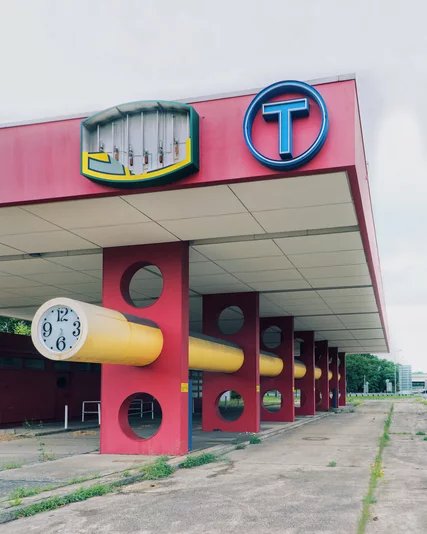
In the past, cars meandered along here at the Dreilinden crossing towards the border crossing; today, only the remains of the border fortifications and the former checkpoint are still visible. Even the former service station, which still presents itself in candy colours, is now just an abandoned, listed building ruin that has long since seen its best days. The cycle path in this section along the A115 motorway leads through an interesting mixture of forest and former border facilities.
By the way: Dreilinden was located at the Allied "Checkpoint Bravo", the name comes from a more peaceful time when - according to Theodor Fontane - there was still a forester's lodge in front of which three lime trees grew.
The reunified Berlin from 1990
Tip 7: Schlösser genießen
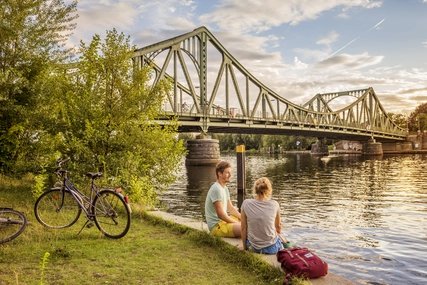
From Griebnitzsee, you will soon reach Wannsee and have a uniquely beautiful view of the three Babelsberg palaces, Glienicke and the Glienicke hunting lodge, which are strung along the Havel like a string of pearls. Two detours that are definitely worth making at this point: the picturesque Pfaueninsel with its beautiful gardens, old trees and meadows, which you can reach via a small ferry.
And the Glienicke Bridge, known as the "Agents' Bridge". Several spectacular exchanges between the USA and the former Soviet Union took place here, during which captured spies and political prisoners were handed over.
Back on the Wall Trail, you reach the border section at Groß Glienicker See, which was both strategically and symbolically important during the division of Germany: the border actually ran through the middle of the lake. A few memorial plaques and an original section of the Wall on the western side are reminders of the division.
By the way: The location is an insider tip for cyclists who want to take a break by the water.
Tip 8: Cycle from the coldest place to the next border tower
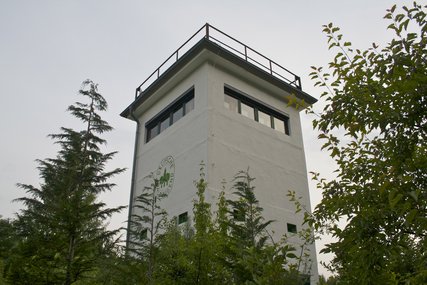
Further on, the Wall Cycle Path leads through rural areas and gives an impression of the remote location and the special history of the area. You reach the small area of Eiskeller, which was an enclave of West Berlin completely surrounded by the GDR during the division. The name says it all: Eiskeller used to be used to store food and the area itself is the coldest place in Berlin.
Via Alt-Kladow and the Rittergut Groß Glienicke, past Fort Hahneberg, you reach the Nieder Neuendorf border watchtower on the banks of the Havel. Just 35 years ago, a wide border strip stretched across the picturesque landscape on the banks of the Havel and this watchtower of the GDR border troops still stands in the middle of nature. At the time, it served as a command post for the Berlin-Brandenburg section of the Wall, which was around ten kilometres long. Today, the tower houses an exhibition that informs you about the construction of the barriers. It also tells the stories of refugees, people who wanted to leave the country and people who opposed the regime.
11 Stations on the Road to Freedom
Tip 9: Follow the Wall Cycle Path via forest paths
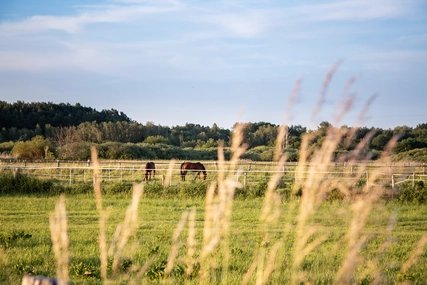
And once again, the landscape changes wonderfully. Now you are travelling along forest paths, through heathland, along watercourses and natural areas. Through the Invaliden housing estate, which was built in the 1930s, and on over the Bieselheide to Glienicke Nordbahn. Pay attention to the double row of cobblestones in this section - they even separate the houses from their gardens.
And another detour is worthwhile: cycle to Alt-Lübars, a charming village with well-preserved, historic buildings, including old farmhouses and the village church. The Lübar Wall Memorial documents the history of the Wall and the associated separation of entire families and friends.
Tip 10: Discover historical and nostalgic things

Back on the Wall Trail, you may come across the Heidekrautbahn. Parts of the railway line are operated by the historic steam locomotive on certain weekends: a nostalgic experience for railway fans and families.
Further along, you will reach Schloss Schönhausen. Originally designed as a summer residence for the Prussian royal family, the palace was built in the Baroque style from 1660. It has an impressive façade and a beautiful park, which has been remodelled several times over the centuries. After the Second World War, the palace became the residence of the socialist government of the GDR and served as a residence for heads of state and foreign guests. Today it is a museum and part of the Prussian Palaces and Gardens Foundation Berlin-Brandenburg. It houses exhibitions on the history of the palace and the Prussian monarchy. Definitely worth a visit and ideal for a longer break.
Tip 11: Head back to Potsdamer Platz

On the last part of the route, the Mauerpark and the Bernauer Strasse Memorial await you. Bernauer Straße was one of the first streets where the Wall was erected in 1961. It symbolises the suffering and escape attempts of many people who were separated by the division. The memorial offers you a deep and comprehensive insight: with the open-air site with original Wall remains, a visitor centre and an exhibition that focuses on the history of the Wall and its impact on people's lives.
In the immediate vicinity is the Nordbahnhof S-Bahn station. During the division, it was a "ghost station" where trains from the West passed without stopping. Today, a documentary in the corridors of the station commemorates this time. A short distance away you can see another, still original border tower, which is also a memorial with a small exhibition: it is dedicated to Günter Liftin, who also tragically lost his life at the Wall. Once you arrive in Berlin-Mitte, you cycle past the Reichstag, the government district and the Brandenburg Gate until you are back at the starting point of the cycle tour.



